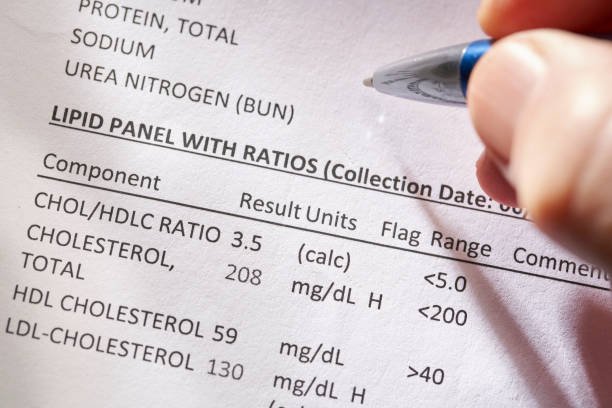
What is Cholesterol? Look At the Density of Lipoproteins to Determine Whether They Are Good or Bad
Everyone has heard about cholesterol, and perhaps knows that too much cholesterol is harmful to the heart and can easily lead to cardiovascular disease. However, you may not know that cholesterol is actually an essential component of the human body. Without cholesterol, people may not be able to survive. This article will help you put aside your preconceptions about cholesterol and re-understand it.
What is cholesterol?
Cholesterol is a lipid molecule that is thick and sticky like fat. Traces of cholesterol can be found in cells in the body because it is the main component of cell membranes. In addition, the body also needs cholesterol to produce hormones, help absorb vitamin D, and digest food.
There are two major sources of cholesterol in the human body. One is that the body naturally produces the required cholesterol, 70~80% of which is produced by the liver. The other is taken from food. Most animal foods include: egg yolks, meat or cheese, etc. Contains cholesterol.
If the cholesterol content in the blood is too high, plaque will easily accumulate in the arteries. This condition is called atherosclerosis, which can lead to narrowing and blockage of blood vessels, leading to coronary heart disease. and other cardiovascular diseases.

Cholesterol and lipoproteins: high and low density scores are good and bad
Most people associate cholesterol with cardiovascular disease, but in fact lipoproteins are the main cause behind the disease.
Lipoproteins and cholesterol are often regarded as the same substance, but they are actually different; the interior of lipoproteins is composed of lipids, and the exterior component is protein, hence the name lipoproteins.
As a type of lipid, cholesterol is naturally wrapped inside lipoproteins. The protein layer makes cholesterol hydrophilic and allows it to flow in the blood. Lipoproteins are like the “Uber” of cholesterol, transporting it throughout the body. cells or organs, so lipoproteins and cholesterol are often confused. Lipoproteins can be roughly divided into the following five categories:
- Chylomicrons:
They are the largest lipoproteins and mainly transport triglycerides. They can be broken down quickly after entering the blood circulation and are not likely to remain on the blood vessel wall, causing atherosclerosis. - Very-low-density lipoprotein (VLDL):
Produced by the liver, it transports triglycerides out of the liver for use by other tissue cells. VLDL can cause the accumulation of plaque in arteries and increase the risk of heart disease, so some people call it one of the bad cholesterols. - Intermediate-density lipoprotein (IDL):
It is an intermediate product of the metabolism of VLDL into LDL, and its content in the blood is very low. - Low-density lipoprotein (LDL):
Recognized as “bad cholesterol”, it accounts for about 60% to 70% in the blood and is responsible for transporting cholesterol molecules. Excessive low-density lipoprotein is closely related to atherosclerosis, but the main difference from VLDL is that VLDL mainly transports triglycerides, while LDL mainly transports cholesterol. In addition, LDL can be subdivided into particles of different sizes, and small-particle low-density lipoprotein (sdLDL) is more likely to cause heart disease, so it is also called “super bad cholesterol.” - High-density lipoprotein (HDL):
Commonly known as “good cholesterol” because HDL can send excess cholesterol attached to blood vessel walls back to the liver for breakdown or utilization. Studies have also shown that HDL can prevent the development of arterial plaque. Accumulate and reduce the risk of cardiovascular disease.

Both good and bad cholesterol are necessary
Some people may avoid the words “bad cholesterol” when they see it. Indeed, all low-density lipoproteins may increase the risk of cardiovascular diseases such as artery blockage, but “cholesterol” itself is not good or bad, and it is the body’s One of the important raw materials for normal operation, most symptoms usually occur during the transportation of “lipoproteins”.
However, the human body cannot be completely free of low-density lipoprotein, otherwise cholesterol will not be transported to extrahepatic tissues for use. Therefore, when it comes to preventing cardiovascular disease, we must still pay attention to the food we eat, exercise and blood lipid status to achieve the ideal preventive effect. (Additional video on the same scene: Can’t you eat meat if your cholesterol is too high? You can feel at ease if you eat these 4 kinds of meat)
Lipoprotein metabolic pathways
As mentioned earlier, cholesterol is mainly produced from two sources in the human body. Likewise, they undergo a series of cyclic degradations through these two channels to provide the cholesterol needed by cells, and are finally recycled through the liver.
Intrinsic pathway
- The liver synthesizes triglycerides from free fatty acids and carbohydrates, and then wraps them in VLDL and enters the blood.
- After reacting with lipoprotein lipase (hereinafter referred to as LPL) in blood vessels and being hydrolyzed, liver oil and fatty acids are released for absorption by fat and muscle tissue. IDL is also produced, part of which will be absorbed by the liver, and the rest. Continue to participate in blood circulation.
- When IDL is hydrolyzed by hepatic lipase, LDL is produced, which can be absorbed by the liver or surrounding tissues to release cholesterol.
Extrinsic pathway
- The intestine absorbs triglycerides and cholesterol from food and lipidizes them to form chylomicrons.
- After chylomicrons enter the lymphatic circulation, they then enter the bloodstream through the thoracic duct.
- It reacts with LPL and hydrolyzes to release glycerol and fatty acids for absorption by surrounding tissues, leaving chylomicron residues.
- Chylomicron remnants continue to circulate until recycled by the liver.
Normal cholesterol range
The total cholesterol value on the physical examination report is calculated from HDL, LDL and triglycerides. The biological reference interval is below 200 mg/dl. If it exceeds 240mg/dl, it is hypercholesterolemia.

Risk factors for excessive cholesterol
Without the habit of regular health check-ups, it is difficult for people to know whether they have high cholesterol. Therefore, if you find that you meet any of the following conditions, it is recommended to undergo a blood lipid test to reduce the chance of high cholesterol causing other diseases. Risk factors for hypercholesterolemia are as follows:
- Eating habits: Unhealthy eating habits can lead to high cholesterol, such as excessive intake of saturated fat from meat, fried or processed foods, or excessive intake of trans fat from self-processed foods. These It will increase the concentration of LDL and bad cholesterol.
- Type 2 diabetes
- Lack of exercise: A sedentary lifestyle with long periods of sitting and little movement will lower the concentration of HDL and good cholesterol.
- Smoking: It will reduce the concentration of HDL and increase the concentration of LDL and bad cholesterol, especially in women.
- Age: The older you are, the more likely you are to have hypercholesterolemia. However, although it is less common in children and adolescents, it is still possible to have high cholesterol.
- Weight: Being overweight and obese can increase cholesterol levels.
- Gene: Familial Hypercholesterolemia (FH) is an inherited form of hyperlipidemia.
- Medications: Certain medications may also cause cholesterol levels to rise.
Too high cholesterol, beware of cardiovascular disease
When the cholesterol in the blood is too high, it may cause hypercholesterolemia (Hypercholesterolaemia), which is a type of hyperlipidemia (Hyperlipidemia), but the latter refers to too high blood lipids in the blood, not just cholesterol.
As mentioned earlier, smaller LDL particles may increase the risk of cardiovascular disease because they are easily oxidized to form oxidized LDL, which causes macrophages to undergo endocytosis to form foam. cells, and then produce a series of related reactions that lead to the gradual formation and enlargement of fatty plaques, which is atherosclerosis.
Atherosclerosis will not only cause blood vessels to narrow and blood flow to be blocked. If the plaque ruptures, it may cause thrombus, block the blood vessels, and cause coronary artery obstruction. In severe cases, it can cause angina or myocardial infarction. Arterial plaque can also form in other parts of the body, such as the brain or extremities, and can lead to carotid artery disease, stroke, or peripheral artery disease (PAD).












